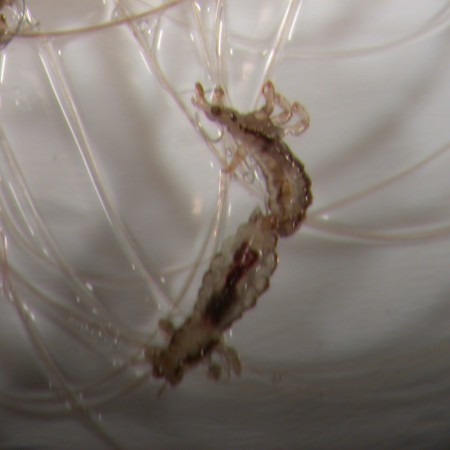How do Lice Reproduce
Adult head lice mate right after they have finished the final cast of skin. The males try to mate with every head louse of a suitable size regardless of the other head louse being adult females, well-developed nymphs in the third stage or other males. The actual mating takes a relatively long time – sometimes up to 30 minutes or more. After the mating, both the male and the female must participate actively to separate from each other. Should one of them die during the mating, they will be stuck together forever.

Head lice mating

… and mating
More info here
Mating Process
Lice begin their reproductive journey soon after reaching adulthood, following their final molt. Adult males actively seek out mates, showing little discrimination when it comes to finding a partner. They will attempt to mate with females, fully-developed third-stage nymphs, and even other males, though only females are capable of laying eggs. Mating is a lengthy process for these tiny parasites, sometimes taking as long as 30 minutes or more. During this time, the male and female remain physically attached, and both must work together to disengage once mating is complete.
Interestingly, if one of the lice dies during the act of mating, the two can remain permanently locked together. Their specialized reproductive anatomy ensures a secure connection, but it also means that separation requires both parties to be alive and cooperative. This unusual characteristic emphasizes the unique adaptations lice have evolved over time to optimize their chances of successful reproduction.
Egg-Laying and Nits
Once mating is complete, the female louse gets to work laying eggs, known as nits. A single female can lay between 50 and 150 eggs throughout her lifespan, which typically lasts around 30 days. The female louse uses a sticky secretion to attach each nit to a hair strand near the scalp, where warmth and humidity provide optimal conditions for development. These eggs are notoriously difficult to remove because they are cemented so firmly to the hair.
Nits take about 7 to 10 days to hatch, at which point the young lice, or nymphs, emerge. These nymphs will go through three molting stages over the course of 9 to 12 days before reaching adulthood and becoming capable of reproducing. Given the speed at which eggs hatch and nymphs mature, a lice population can increase rapidly in a short amount of time, which is why infestations often escalate so quickly.
Rapid Population Growth
The rapid reproductive cycle of lice allows them to multiply at an alarming rate under favorable conditions. With females capable of laying multiple eggs daily and nymphs maturing into reproductive adults in just over a week, a small number of lice can lead to a large infestation within weeks. This reproductive efficiency is one of the main reasons lice are difficult to control, especially in environments where close contact is common, such as schools and households.
Preventing lice infestations requires an understanding of their life cycle and how quickly they reproduce. Swift intervention with treatments that target both live lice and their eggs is crucial to preventing further spread and breaking the cycle of reproduction.
